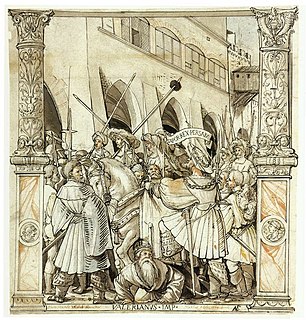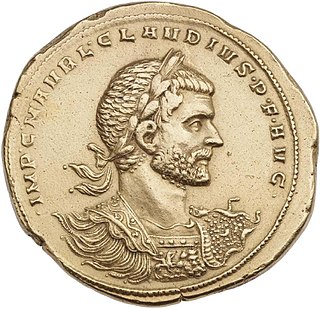Related Research Articles

Publius Licinius Egnatius Gallienus was Roman emperor with his father Valerian from 253 to 260 and alone from 260 to 268. He ruled during the Crisis of the Third Century that nearly caused the collapse of the empire. He won a number of military victories against usurpers and Germanic tribes, but was unable to prevent the secession of important provinces. His 15-year reign was the longest in half a century.
The 260s decade ran from January 1, 260, to December 31, 269.

Year 260 (CCLX) was a leap year starting on Sunday of the Julian calendar. At the time, it was known as the Year of the Consulship of Saecularis and Donatus. The denomination 260 for this year has been used since the early medieval period, when the Anno Domini calendar era became the prevalent method in Europe for naming years.

Marcus Aurelius Claudius 'Gothicus', also known as Claudius II, was Roman emperor from 268 to 270. During his reign he fought successfully against the Alemanni and decisively defeated the Goths at the Battle of Naissus. He died after succumbing to "pestilence", possibly the Plague of Cyprian that had ravaged the provinces of the Empire.

Valerian was Roman emperor from 253 to spring 260 AD. He persecuted Christians and was later taken captive by the Persian emperor Shapur I after the Battle of Edessa, becoming the first Roman emperor to be captured as a prisoner of war, causing shock and instability throughout the Roman Empire. The unprecedented event and the unknown fate of the captured emperor generated a variety of different reactions and "new narratives about the Roman Empire in diverse contexts".

The Gallic Empire or the Gallic Roman Empire are names used in modern historiography for a breakaway part of the Roman Empire that functioned de facto as a separate state from 260 to 274. It originated during the Crisis of the Third Century, when a series of Roman military leaders and aristocrats declared themselves emperors and took control of Gaul and adjacent provinces without attempting to conquer Italy or otherwise seize the central Roman administrative apparatus.

Marcus Cassianius Latinius Postumus was a Roman commander of Batavian origin who ruled as Emperor in the West. The Roman army in Gaul threw off its allegiance to Gallienus around the year 260, and Postumus assumed the title and powers of Emperor in the provinces of Gaul, Germania, Britannia and Hispania, thereby founding what scholars have dubbed the Gallic Empire. He ruled for the better part of ten years before he was murdered by his own troops.

Gaius Pius Esuvius Tetricus was the emperor of the Gallic Empire from 271 to 274 AD. He was originally the praeses (governor) of Gallia Aquitania and became emperor after the murder of Emperor Victorinus in 271, with the support of Victorinus's mother, Victoria. During his reign, he faced external pressure from Germanic raiders, who pillaged the eastern and northern parts of his empire, and the Roman Empire, from which the Gallic Empire had seceded. He also faced increasing internal pressure, which led him to declare his son, Tetricus II, caesar in 273 and possibly co-emperor in 274, although this is debated. The Roman emperor Aurelian invaded in 273 or 274, leading to the Battle of Châlons, at which Tetricus surrendered. Whether this capitulation was the result of a secret agreement between Tetricus and Aurelian or necessary after his defeat is debated. Aurelian spared Tetricus, and even made him a senator and corrector (governor) of Lucania et Bruttium. Tetricus died of natural causes a few years after 274.

Titus Fulvius Junius Quietus was a Roman usurper against Roman Emperor Gallienus.

Aureolus was a Roman military commander and would-be usurper. He was one of the so-called Thirty Tyrants who populated the reign of the Emperor Gallienus. Of humble Daco-Roman origins, he was 'made' by the Emperor Gallienus and proved himself to be one of the most brilliant and innovative soldiers of the age. However, he later turned against his benefactor, and was destroyed in the political turmoil that surrounded the Emperor's assassination in a conspiracy orchestrated by his senior officers. The ancient sources which refer to Aureolus are limited and the information they do provide is often contradictory. They include the Historia Augusta, Zonaras' epitome and Zosimus' Historia Nova. His career was most recently summarised in John Bray's biography of Gallienus. The analysis of Aureolus's career given here, especially his final rebellion, is largely based on Bray.

Publius Licinius Cornelius Valerianus, also known as Valerian II, was the eldest son of Roman Emperor Gallienus and Augusta Cornelia Salonina who was of Greek origin and grandson of the Emperor Valerian who was of a noble and traditional senatorial family.

Valens Thessalonicus was a Roman usurper during the reign of Emperor Gallienus.
The Gallienus usurpers were the usurpers who claimed imperial power during the reign of Gallienus. The existence of usurpers during the Crisis of the Third Century was very common, and the high number of usurpers fought by Gallienus is due to his long rule; 15 years was a long reign by the standards of the 3rd century Roman Empire.

Publius Licinius Cornelius Saloninus Valerianus, typically just called Saloninus, was a Roman nobleman who briefly became Emperor in 260. The grandson of Valerian I, Saloninus was appointed (subordinate) Caesar in 258 in an attempt to shore up the Licinial line of succession during the Crisis of the Third Century. During his time in power, Saloninus administered the German marches out of Cologne. Nevertheless, Saloninus soon became embroiled in a dispute with future Caesar of the Gallic Empire Postumus over war spoils. In 260, Saloninus' troops acclaimed him Emperor in an unsuccessful bid for political legitimacy; Postumus killed Saloninus shortly thereafter.

The Battle of Edessa took place between the armies of the Roman Empire under the command of Emperor Valerian and Sasanian forces under Shahanshah Shapur I in 260. The Roman army was defeated and captured in its entirety by the Persian forces; for the first time, a Roman emperor was taken prisoner. As such, the battle is generally viewed as one of the worst disasters in military history.

The Battle of Mediolanum took place in 259, between the Alemanni and the Roman legions under the command of Emperor Gallienus.
Marcus(?) Aurelius Heraclianus was a Roman soldier who rose to the rank of Praetorian Prefect in the latter part of the reign of the Emperor Gallienus. He was a member of the cabal of senior commanders of the Imperial field army that plotted and achieved the assassination of the Emperor Gallienus. His subsequent fate is uncertain. The only ancient reference has him committing suicide, but the circumstances are unclear.
Lucius Petronius Taurus Volusianus was a Roman citizen, apparently of equestrian origins, whose career in the Imperial Service in the mid-Third Century AD carried him from a relatively modest station in life to the highest public offices and senatorial status in a very few years. He may have secured his first appointments before the Licinian Dynasty — — acceded to the Empire in 253 AD, but it was in the course of their reign that his upward progress achieved an almost unprecedented momentum and the second factor seems to have been a consequence of the first. The nature of his relationship to the Licinii is uncertain, but it seems likely that a common origin in the Etruscan region of central Italy at least predisposed Gallienus in his favour and he seems to have been that emperor's most trusted servant and adviser during the period of his sole reign - 260(?)-268 AD.
Protector Augusti Nostri was a title given to individual officers of the Roman Army as a mark of their devotion to and approval by the Emperor himself. The term first appears with this meaning in the joint-reign of Valerian and Gallienus. L. Petronius Taurus Volusianus was the first recorded Protector appointed by Gallienus.
Successianus was a Roman soldier, general and praetorian prefect in the third century AD of whom very little is known for certain. He is said to have distinguished himself as commander of the garrison of an allied city besieged by barbarian pirates, and then made praetorian prefect by the emperor Valerian on the strength of this. As praetorian prefect appears to have done useful work in restoring Antioch, the capital of the Roman East, after the devastation which had been inflicted by Shapur, the King of the Persians, in his invasion of 252. However, he was overwhelmed by the circumstances with which he had to contend when Shapur invaded on a second occasion in 260 and seems to have shared in the defeat of Valerian at the Battle of Edessa and his subsequent captivity in Persia.
References
- ↑ Zosimus; Trans. J. Buchanan and H.T. Davis (1967). Historia Nova, i.38. San Antonio, Texas: Trinity University Press.CS1 maint: multiple names: authors list (link)
- ↑ Ioannes Zonaras, Ed. Maurice Pinder (1844). Annales xii 24, Vol. 2, pp 597 f. Bonn.
- ↑ Parker, H.M.D. (1966). A history of the Roman World from AD 138-337. MacMillan Co.